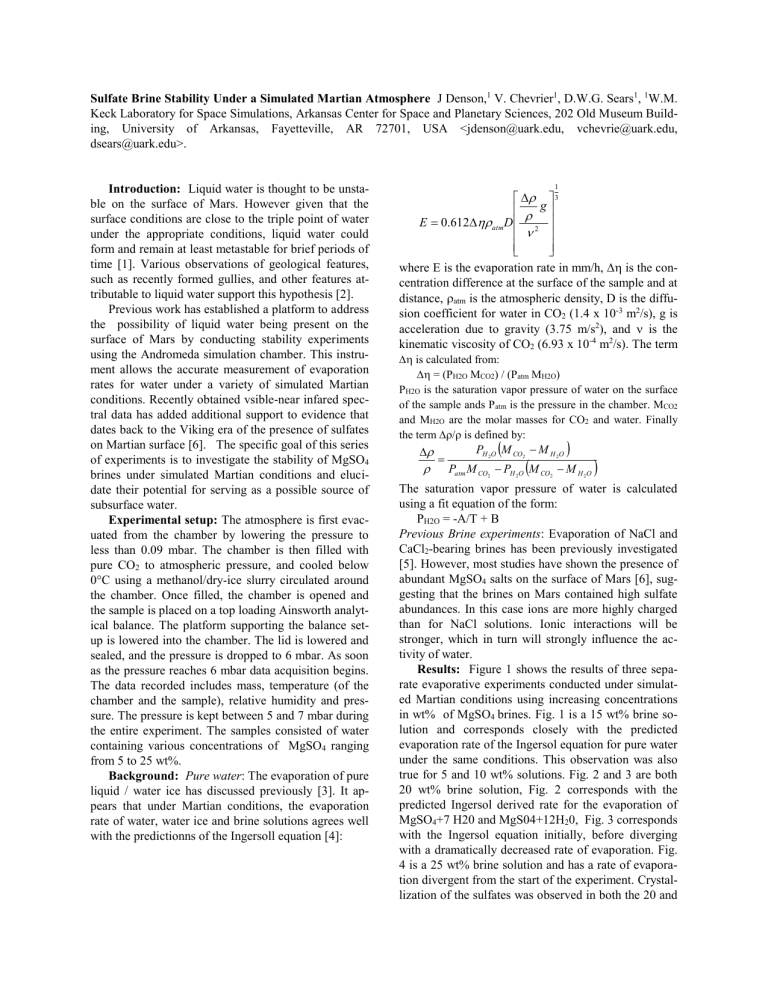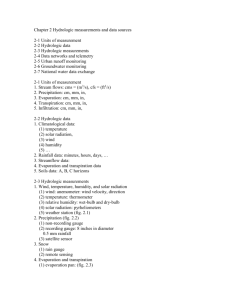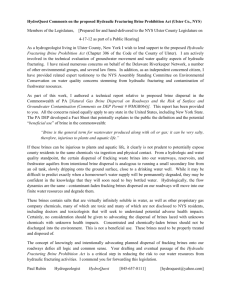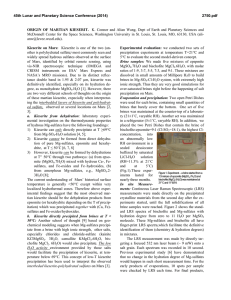Abstract - Arkansas Center for Space and Planetary Sciences
advertisement

Sulfate Brine Stability Under a Simulated Martian Atmosphere J Denson,1 V. Chevrier1, D.W.G. Sears1, 1W.M. Keck Laboratory for Space Simulations, Arkansas Center for Space and Planetary Sciences, 202 Old Museum Building, University of Arkansas, Fayetteville, AR 72701, USA <jdenson@uark.edu, vchevrie@uark.edu, dsears@uark.edu>. Introduction: Liquid water is thought to be unstable on the surface of Mars. However given that the surface conditions are close to the triple point of water under the appropriate conditions, liquid water could form and remain at least metastable for brief periods of time [1]. Various observations of geological features, such as recently formed gullies, and other features attributable to liquid water support this hypothesis [2]. Previous work has established a platform to address the possibility of liquid water being present on the surface of Mars by conducting stability experiments using the Andromeda simulation chamber. This instrument allows the accurate measurement of evaporation rates for water under a variety of simulated Martian conditions. Recently obtained vsible-near infared spectral data has added additional support to evidence that dates back to the Viking era of the presence of sulfates on Martian surface [6]. The specific goal of this series of experiments is to investigate the stability of MgSO4 brines under simulated Martian conditions and elucidate their potential for serving as a possible source of subsurface water. Experimental setup: The atmosphere is first evacuated from the chamber by lowering the pressure to less than 0.09 mbar. The chamber is then filled with pure CO2 to atmospheric pressure, and cooled below 0°C using a methanol/dry-ice slurry circulated around the chamber. Once filled, the chamber is opened and the sample is placed on a top loading Ainsworth analytical balance. The platform supporting the balance setup is lowered into the chamber. The lid is lowered and sealed, and the pressure is dropped to 6 mbar. As soon as the pressure reaches 6 mbar data acquisition begins. The data recorded includes mass, temperature (of the chamber and the sample), relative humidity and pressure. The pressure is kept between 5 and 7 mbar during the entire experiment. The samples consisted of water containing various concentrations of MgSO4 ranging from 5 to 25 wt%. Background: Pure water: The evaporation of pure liquid / water ice has discussed previously [3]. It appears that under Martian conditions, the evaporation rate of water, water ice and brine solutions agrees well with the predictionns of the Ingersoll equation [4]: 1 3 g E 0.612atmD 2 where E is the evaporation rate in mm/h, is the concentration difference at the surface of the sample and at distance, atm is the atmospheric density, D is the diffusion coefficient for water in CO2 (1.4 x 10-3 m2/s), g is acceleration due to gravity (3.75 m/s2), and is the kinematic viscosity of CO2 (6.93 x 10-4 m2/s). The term is calculated from: = (PH2O MCO2) / (Patm MH2O) PH2O is the saturation vapor pressure of water on the surface of the sample ands Patm is the pressure in the chamber. MCO2 and MH2O are the molar masses for CO2 and water. Finally the term / is defined by: PH 2O M CO2 M H 2O Patm M CO2 PH 2O M CO2 M H 2O The saturation vapor pressure of water is calculated using a fit equation of the form: PH2O = -A/T + B Previous Brine experiments: Evaporation of NaCl and CaCl2-bearing brines has been previously investigated [5]. However, most studies have shown the presence of abundant MgSO4 salts on the surface of Mars [6], suggesting that the brines on Mars contained high sulfate abundances. In this case ions are more highly charged than for NaCl solutions. Ionic interactions will be stronger, which in turn will strongly influence the activity of water. Results: Figure 1 shows the results of three separate evaporative experiments conducted under simulated Martian conditions using increasing concentrations in wt% of MgSO4 brines. Fig. 1 is a 15 wt% brine solution and corresponds closely with the predicted evaporation rate of the Ingersol equation for pure water under the same conditions. This observation was also true for 5 and 10 wt% solutions. Fig. 2 and 3 are both 20 wt% brine solution, Fig. 2 corresponds with the predicted Ingersol derived rate for the evaporation of MgSO4+7 H20 and MgS04+12H20, Fig. 3 corresponds with the Ingersol equation initially, before diverging with a dramatically decreased rate of evaporation. Fig. 4 is a 25 wt% brine solution and has a rate of evaporation divergent from the start of the experiment. Crystallization of the sulfates was observed in both the 20 and 1.00 0.99 Relative mass 1.00 Relative mass 0.98 0.96 0.94 data 0.92 Ingersoll pure water 0.90 MS7 MS12 0.88 0 20 40 60 80 100 120 Time (mn) Fig. 2 MgSO4 20 wt% 1.00 Relative mass 0.99 0.98 data 0.97 Ingersoll pure water Series1 0.96 Linear (Series1) 0.95 0 20 40 60 80 100 120 Time (mn) Fig. 3 MgSO4 20 wt% 1.00 0.99 Relative mass 25 wt% solutions which showed dramatic decreases in evaporation rate, and their respective slopes agree. Conclusions: Numerous experiments were conducted to investigate the evaporation of MgSO4 brines of varying concentrations under simulated Martian conditions. The results suggest that highly concentrated brines have a dramatic effect on the stability of water under these conditions. Crystallization was observed at high brine concentrations. The hydration state of these crystals is currently being investigated utilizing X-Ray diffraction. This study provides initial evidence that sulphate minerals could conceivably serve as a reservoir of subsurface water on large regions of the Martian surface, potentially accounting for some percentage of the speculated subsurface water in these regions. Future work will examine the effect of a variety of conditions on the stability of these brines, including the effects of regolith layers, ice/sulphate interactions, wind conditions, and illumination. Acknowledgements: This program was funded by the W.M. Keck Foundation We would also like to thank Walter Graupner, Julie Chittenden, and Kathryn Bryson for technical assistance. References: [1] Richardson M. I. and Mischna M. A. (2005) J. Geophys. Res., 110, doi.10.1029/2004 JE002367. [2] Heldmann J. L. et al. (2005) J. Geophys. Res., 110, doi.10.1029/2004JE002261. [3] Sears D. W. G. and Moore S. R. (2005) Geophys. Res. Lett., 32, doi.10.1029/2005GL023443. [4] Ingersoll A. P. (1970) Science, 168, 972-973. [5] Sears D. W. G. and Chittenden J. D. (2005) Geophys. Res. Lett., 32, doi.10.1029/2005GL024154. [6] Gendrin A. et al. (2005) Science, 307, 1587-1591. [7] Scatchard G. (1936) Chem. Rev., 19, 309-327. 0.98 data 0.97 Ingersoll pure water 0.98 Linear (data) 0.96 0.97 0.96 0.95 data 0 0.95 Ingersoll pure water 20 40 60 80 100 Time (mn) 0.94 Fig. 4 MgSO4 25 wt% Linear (data) 0.93 0 20 40 60 80 Time (mn) Fig. 1 MgSO4 15 wt% 100 120 Figures 1-4. Evaporation curves for liquid brine containing initially 15 wt% (Fig. 1), 20 wt% MgSO4 (Fig. 2 and 3) and 25 wt% (Fig. 4). The blue curve is calculated from the Ingersoll equation including pressure and temperature variations as measured during the experiment. 120








